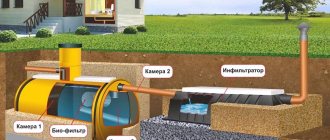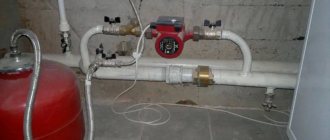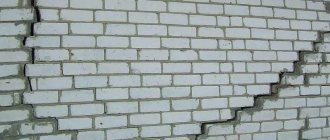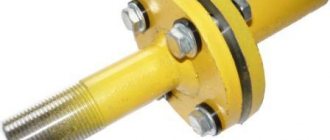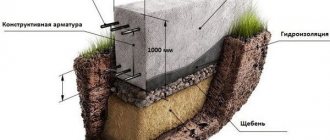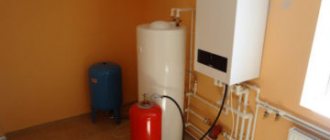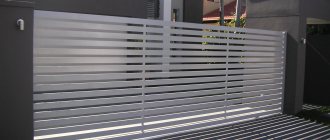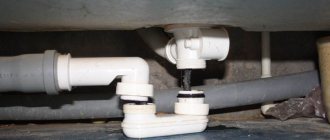Sewerage is one of the most important engineering systems of a country house. The level of comfort of those living in the cottage largely depends on its correct and uninterrupted operation. Often, novice developers, trying to save money, rush to make a septic tank without proper knowledge about the absorption capacity of the soil on the site, the groundwater level and sanitary standards applicable to this type of structure. As a result, the septic tank turns into an ordinary cesspool filled with water.
The matter is aggravated by the fact that no one has the desire to dig up pipes or climb into already commissioned wells filled with “black and gray waters” in order to eliminate a breakdown or carry out modernization. There is only one way out - to do everything right the first time, and the experience of a portal user with the nickname PavelTLT will help you with this.
What is a septic tank
In other words, a septic tank can be called an autonomous mini treatment facility that replaces a cesspool. This is a large capacity container consisting of several sections. It collects, settles and purifies wastewater used for economic and domestic needs.
Scheme of the device of light weapons in a private house
Septic tanks are elements of local treatment systems (LSS). With their help, the problem of sewerage installation in areas that do not have centralized water treatment systems is solved. The choice of LSO design depends on various factors. Among them:
- volume of wastewater requiring treatment;
- landscape features of the site where the sewerage system is being installed;
- financial capabilities of owners of private housing construction.
The most primitive and cheapest option for a septic tank is a storage tank. It is a metal barrel dug into the ground. The collection of dirty waste into it occurs in the same way as in a cesspool. The metal barrel is distinguished from the latter by a more advanced version of the design. It has a hermetically sealed lid, which limits the spillage of sewage throughout the area and prevents the spread of unpleasant odors.
Storage tank for domestic and household wastewater for a summer residence
A disadvantage of the design is the need to constantly monitor the level of the contents of the container. A sewer truck is used to pump it out. It only makes sense to install storage tanks at dachas that are not intended for permanent residence.
Types of septic tanks
Based on the principle of sewage treatment, autonomous collectors are divided into:
- accumulative;
- with soil filtration;
- with forced aeration.
When installing a personal protective equipment for a country house, they try to choose a septic tank that has the ability to deeply treat wastewater. This eliminates the problem of pumping out the contents of storage tanks. Industrially produced designs cannot provide complete wastewater treatment. Their purification is carried out using filtration fields.
Septic tank "Topas"
The maximum degree of wastewater treatment can be achieved only in VOCs, the operating principle of which is based on biological methods. Such structures are equipped with a forced aeration system. They must be connected to the electrical network.
Table 1. Types, advantages, disadvantages of septic tanks
| Type of septic tank | Characteristics | Advantages | Flaws |
| Single chamber | Installed in houses with a daily water consumption of no more than 1 m³. | Easy to install and operate. Low cost. | Small capacity. No chemical cleaning. |
| Double chamber | It is recommended to install in houses with no more than 4 people living in them. | Reliability and safety. Easy to use. Long service life. | High price. Impossibility of self-installation. |
| Three or more cameras | Installed in cottages with high water consumption. | Relatively high degree of wastewater treatment. Compliance with sanitary standards. | Heavy weight. Unpleasant odor emanating from the container. |
Construction of the sewerage system
Digging trenches from a private house to a septic tank
Trenches for pipes with a diameter of 110 mm and a width of 40-45 cm are dug with a slope of 2% or 2 cm for each linear meter. The digging depth is calculated so that the base is located at a depth of 1.60 m. This will allow the cushion to be poured out and the pipes and entrance to the septic tank to be located below the freezing point.
When laying pipes above the freezing depth, they are insulated with heat-insulating materials or using a low-current electrical cable.
Pipe entry into the base/foundation
The entrance to the house on a pile foundation is mounted in accordance with the developed septic tank connection diagram.
A hole is made in the strip foundation for the drain pipe using diamond drilling
The pipe is insulated.
Sewage pump
If purified water will be used for technical needs, a water inlet is installed when installing a septic tank in a private house. Recycled water from the septic tank enters it through a drain pipe and/or is pumped by a pump.
The pump is attached to a plastic pipe, the float is placed at a distance of 3 cm from the body. The holes in the reservoir for the pump pipe and the inlet to the drainage pipe are sealed with rubber cuffs.
When installing the pipe and pump, the septic tank will not overflow in any case.
Fan ventilation
Installing a ventilation system will prevent stagnant processes in the sewer system and the spread of unpleasant odors. The easiest way is to place it above the septic tank, which of course will worsen the visual perception of the landscape.
Therefore, the fan pipe is located near fences or walls, most often inside a residential building. In this case, the costs of its fastening and insulation are minimal. The upper part should protrude 30-50 cm above the ridge. The head is equipped with a deflector.
We told you how to properly install a septic tank and are ready to answer all your questions in detail.
Do-it-yourself septic tank installation for a private home
Work on installing a septic tank in a suburban area begins with calculating the volume of the tank and drawing up a plan for its placement. According to current SNiP, sewerage structures should not be located closer than 5 m from the foundations of residential buildings. They should be separated from water intakes by at least:
- on clay soils 20 m;
- on sandy soil 50 m.
Installation of a concrete septic tank
The distance to the fence and outbuildings should be at least 1 m and 5 m to the road. Such strict sanitary and technical standards established by building regulations seriously limit the possibilities of planning a sewerage system. The problem of wastewater treatment can be solved in 2 ways:
- buy and install an industrial septic tank on the site;
- build a treatment structure from scrap materials.
Construction of a septic tank made of concrete rings
The classic design of a septic tank made of concrete rings consists of 2 or 3 tanks. They are wells, each of which has its own functional purpose:
- The 1st well serves as a wastewater receiver. Their heaviest particles settle in it. In this compartment, organic substances are decomposed into simple elements. The process is initiated by anaerobic bacteria. It passes without access to oxygen.
- The 2nd well is intended for additional filtration of wastewater settled in the 1st tank. This compartment is equipped with mesh or gravel filters.
- The 3rd well is installed for final filtration of used water. Unlike the first two tanks, the bottom is not concreted. It is covered with layers of sand and crushed stone of the middle fraction.
The volume of the first tank must be at least half of the calculated daily water consumption.
Diagram of a septic tank made of concrete rings.
The advantages of a design made of concrete rings are:
- ease of installation;
- low price;
- structural strength;
- long service life.
The large mass of concrete rings does not allow groundwater to push them out of the ground during spring floods. The disadvantage of a septic tank made of concrete rings is the impossibility of their installation without the use of special equipment. The seams between the rings require careful sealing. Concrete is hygroscopic, which prevents the use of structures made from it in flooded areas. The maximum degree of wastewater treatment is provided by 3-section structures.
However, with concrete septic tanks there is a lot of hassle in ensuring the chambers are completely sealed. One of the modern convenient and reliable solutions to this problem is a polymer insert into a concrete septic tank. We will talk in more detail about the advantages of polymer liners in a special article.
What to consider when installing the structure
A septic tank made of concrete rings is not recommended for installation in areas with a high aquifer. In case of possible violation of the tightness of the structure, groundwater will fill the container, pushing sewage out of it into the soil. You will have to regularly call a sewer truck.
The strength of the concrete structure must be increased by installing metal strapping around the rings. A cushion of sand, crushed stone or gravel is placed around the tank. This reduces the degree of ring subsidence.
Installation of concrete structure
Step-by-step instructions for installing a septic tank made of concrete rings
Step 1. We calculate the volume of the structure and draw up a design diagram. The calculation is based on the three-day volume of wastewater. For a family of 2 people, it is enough to install a septic tank with a volume of 2 cubic meters. When 5-6 people live in a house, the volume of the structure should be at least 3-4 cubic meters.
Structural diagram
It is recommended to apply an increasing factor to the tank volume obtained in the calculation in case of guests arriving.
Video - Calculation of the volume of a septic tank to the house
Step 2. Preparing materials and tools for work. In addition to concrete rings, for the installation of light weapons you will need:
- fine crushed stone, river sand, gravel, cement, waterproofing compounds, thermal insulation materials;
- pipes for external sewerage;
- ladder, hammer drill, molar brush, containers for preparing the solution.
Pipes for external sewerage
Step 3. Selecting a location on the site to install the structure. We take measurements using a tape measure in accordance with SNiP.
Site marking
Step 4. Digging a pit and trench for laying sewer pipes. The work is carried out manually or using specialized equipment. It is recommended to dig a pit after the onset of the first frost or in hot weather in the summer. The size of the pit should be 50-80 cm larger than the space occupied by the rings. The depth of the trench is below the freezing mark of the soil.
Digging a pit
Step 5. We arrange the bottom of the pit. In the summer, before installing the rings, it is recommended to water it generously. This promotes better soil settlement. The moistened pit is left to dry for 2-3 days, after which a cushion of sand, crushed stone or gravel is built at its bottom. Its thickness should be at least 20 cm. The bottom slope is 2-3 mm per 1 p/m. When pouring a cushion onto the bottom of the pit, tamping is alternated with watering it. Part of the cushion constructed in this way is concreted for installing the rings of 2 wells. The thickness of the concrete pad is 30 cm.
Gravel bed filling
Step 6. Installation of rings and pipes, sealing joints. The rings are installed strictly vertically. Control during installation is carried out using a level. Sealing of joints is carried out using special mixtures.
Installation of concrete rings in the pit
Step 7. Waterproofing the structure. The external and internal surfaces of the septic tank are covered with waterproofing mixtures. They can be replaced with liquid bitumen.
Waterproofing
It is strictly forbidden to use toxic materials to waterproof the internal surfaces of wells.
Step 8. Close the top of the wells with hatches. After installing the hatches on the wells, they are insulated. This can be done using polystyrene foam.
Insulation of well hatches
Step 9. Fill the pit. The gaps between the rings must be compacted with medium or coarse crushed stone.
Backfilling the pit
A little about filtration fields and high groundwater level
The high groundwater level imposes its own difficulties on the construction of sewerage systems.
- Concrete rings can no longer be used. Plastic has good waterproofing properties, but it is prone to floating and requires anchoring.
An example of anchoring a septic tank with anchorsAnd watered soil is susceptible to heaving at low temperatures, which causes the soil to put pressure on the plastic tank. To protect the septic tank, backfilling is done with a sand-cement mixture, periodically wetting it with water and tamping.
Backfilling with cement-sand mixtureOr you can use a metal container or, during the dry period, build a monolithic concrete tank, treating it with waterproofing.
Monolithic concrete septic tank with waterproofing - A well with a drainage bottom is an effective, simple and inexpensive soil filtration system. However, if groundwater rises high at least during a flood, this option for post-treatment is not suitable. In this case, either filtration fields are set up or infiltration cassettes are installed on an artificially created hill.
Infiltrator for septic tank
Filtration fields consist of several perforated sewer pipes laid on a bed of sand and gravel. Such a system occupies a fairly large area and is labor-intensive to install.
An infiltration cassette is a wide container with a filter pad instead of a bottom. If the groundwater is at a depth of less than 1 m, then fill the filter material higher, and then install a cassette and cover it with soil.
The design of the infiltrator and the principle of its operation
At high GWL, the post-treatment stage is often located higher than the sealed tank. For this reason, a submersible pump with a float mechanism is installed in the latter. A check valve is installed on the pipe that discharges partially treated wastewater into the soil filter.
A high groundwater level increases the final cost of the septic tank, so in this case you need to especially soberly assess your strengths. If in doubt, it is better to entrust the matter to professionals.
But in general, having tools and general construction skills, a competent approach and following the rules will help you build your own budget septic tank in the country without pumping.
Construction of a brick septic tank
Brick is one of the most common and affordable types of building materials. Septic tanks made from it for private houses have a number of advantages. They are durable and have a reliable design. Their installation does not require the use of special equipment or the use of expensive tools. The material allows you to create structures of various sizes and shapes.
The disadvantage of septic tanks made of brick is their low insulating properties. Well walls require additional protection from environmental influences. The second disadvantage is the laboriousness of the process. It takes a lot of time to build the walls of a structure.
What is important to consider
When creating a design drawing for a 3-section septic tank, it is necessary to correctly distribute the percentage of the volumes of each compartment:
- reception collection - 50%;
- aerobic cleaning chamber - 30%;
- output compartment - 20%.
Laying a brick septic tank
This ratio of the volumes of the structure’s compartments will allow you to achieve the maximum degree of wastewater treatment. The mortar that binds the bricks is made from cement grade M 400. The best type of brick is solid clay. This type of brick is the most resistant to aggressive environments, which include sewage. Despite the strength of clay bricks, the walls of wells are plastered with concrete mortar and covered with a layer of mastic. You can replace the concrete screed with a clay solution. It has an increased degree of resistance to runoff.
For ease of maintenance of the structure, it is recommended to make the depth of the compartments from 1.2 m to 3 m. The optimal thickness of the external walls is 25 cm, internal - 12 cm. When installing a 2-chamber septic tank, the volume of the receiving compartment must be at least 1 cubic meter. and account for 75% of the total cubic capacity of the structure. The cross-section of the transition holes between the compartments is 150*150 mm. The bottom of the septic tank is concreted and waterproofed. To cover the top of the structure, it is better to use concrete slabs with holes for sewer hatches.
Concrete slabs with holes for manholes
A ventilation hole must be provided in the design. It is made from asbestos pipe. It is taken out away from the septic tank at a distance of at least 600 mm. The concrete slab with hatches is insulated and covered with soil.
Connecting additional electrical equipment
In some cases, it is necessary to connect the septic tank to electricity: when there is electrical equipment for lifting and pumping liquid between the chambers and when the chambers are equipped with aerators.
The question arises, how to connect the septic tank to electricity if you need to clean it? In some models, the drainage pump is installed inside the chamber. But it is not necessary to fix the pump in the container, since it becomes necessary to use it approximately once every 2–4 years.
This is interesting!
Autonomous sewage system for a private home: types, operating principle Read more
You can also hang a stationary pump. To do this you will need a pipe with a diameter of 32 mm. In those places where the pipe enters the container, a bend with a threaded connection is installed. This place must be sealed. The cable is connected to the pipe and fixed using plastic clamps. The cable comes out of the side wall.
Electrical equipment is under warranty. Therefore, the manufacturer’s specialists themselves configure, check and launch the autonomous cleaning system. They also regulate the power of the aerators and prepare the automatic control units for switching on. These blocks in factory septic tanks are located inside the tanks. They are accessed through the top hatches.
The owner of the site must lay a cable from the septic tank and connect it to electricity from the house. The removed cable must be insulated from moisture and damage. The cable coming out of the wall of the septic tank is sealed with a flexible coupling.
The rest of the cable is insulated with a rigid plastic corrugated pipe and laid in a prepared trench. This is a necessary measure to protect the cable from kinks, damage from stones or moisture. After this, you need to do a test run of all the equipment and then fill the trench.
Many people wonder how to properly connect a septic tank to a house, and whether or not they should equip it themselves. If the system is complex, then, without a doubt, the work should be entrusted to professionals. They will correctly calculate all the angles of inclination, digging depth, do all the work up to preparation for launch and conduct a test run.
It is almost impossible to do this on your own without errors. The slightest flaws can lead to equipment failure or other problems. You can make a sewer system with your own hands if it is planned to be simple, not equipped with pumps and other equipment.
;
Septic tank
Did you find this article helpful? Share it with your friends:
Installation of a septic tank in clay soil
The ability to process water in loamy soils is 2 times lower than in sandy loam soil. The depth of the clay layer is rarely more than 2-3 m thick. Before constructing wells, it is necessary to thoroughly study the structure of the local soil. If you manage to lower the bottom of the septic tank below the thickness of the clay, it will work better than on homogeneous soils. The reason for this is the high level of pressure of the water column located inside the septic tank of treated wastewater. The performance of treatment plants depends on:
- from their laying depth;
- groundwater level;
- area of the walls of the structure.
You can install factory-made septic tanks or home-made structures in clay soils. Despite its poor water throughput, clay is considered the best soil filter. This property allows you to build septic tanks without a bottom on this type of soil. The best option for them may be designs that use the soil purification method. They resemble storage tanks.
Installing a septic tank in clay soil
The simplest option for constructing a reservoir with soil post-treatment is to use a metal barrel without a bottom. When constructing wells from brick or concrete rings, a drainage layer is made at the bottom of the structure. It is made from geotextiles, river sand and crushed stone of medium or fine fraction. The thickness of the drainage layer should be from 30 to 40 cm. Septic tanks without a bottom cannot be installed in areas with drilled drinking water wells.
The influence of topography on the choice of location for installing a septic tank
Laying the external main
The pipe is laid with a certain slope.
From the point where the sewer pipe exits the house to the septic tank, it is necessary to lay a pipeline. The main must lie at a slope that ensures the drainage of contaminated water. The larger the diameter of the pipes you use, the smaller the angle of inclination required for their operation, on average it is 2 degrees. The depth of the trench for laying pipes must be greater than the amount of winter freezing of the soil. If the depth of the trench is small, provide thermal insulation of the line.
The average depth for laying a sewer system is 1 meter; in warm regions it is enough to go down to 70 cm, and in cold regions you will need to dig a pit up to 1.5 meters. The bottom of the dug hole is covered with a dense cushion of compacted sand. This procedure will protect the pipes from soil displacement.
A pit for a septic tank near the fence.
The best option would be to lay a direct pipeline to the collector. If it is necessary to make a turn, this place will be equipped with an inspection well. For the main line, you can use plastic and cast iron pipes with a diameter of 110 mm; their connection must be airtight. After installation, the pipeline is covered with sand and then with soil.
Cost of installing a septic tank for a private home
We have already made a calculator for calculating the cost of installing a finished septic tank - in this article. Be sure to check it out!
When calculating the costs of installing a local sewer system, it is necessary to take into account not only the costs of installing the system, but also its operation. Storage tanks are the cheapest to install. The need for constant cleaning of containers using special equipment makes this wastewater collection system the most expensive. The amount of costs for each specific case consists of individual cost items. The most economical are septic tanks made of concrete rings and bricks.
SALW with biological treatment system
Photo
Digging a hole
Laying the outer pipe
Pipe laying
Laying out sewer pipes Formwork for a concrete septic tank
Concrete septic tank
Concrete cesspool
Cover formwork
Concreting a septic tank
Septic tank from eurocubes
Sewerage from rings
Installation of rings with holes Installation of several wells Inspection well
Brick septic tank
Autonomous septic tank for a summer residence
The sewage system at the dacha is decorated
The best factory-made septic tanks
Domestic manufacturers began producing wastewater treatment systems at the beginning of the century. During this time, they have created a wide range of different models. The most popular septic tanks are:
- Eurobion. The products are produced by the Yubas association. The structures are equipped with innovative membranes that provide a high degree of wastewater treatment. The advantage of the complexes is the ability to use them even after a long period of inactivity.
- "Tank". The model is being released. The capacity of the complex is designed to process wastewater with a volume of 1200 l/day.
- "Aster". The complexes are produced. Cleans wastewater by 75%.
- "Tver". Equipped with a pumping system. complex releases . LSO can carry out mechanical and biological treatment. Productivity 750-1500 cubic meters/day.
- "Topas". The energy-dependent model has 4 sections. The degree of wastewater treatment is 98%. Such wastewater can be discharged into natural reservoirs or used for irrigation.
Septic tank “Tank” connected to a drainage tunnel (soil infiltrator)
The choice of industrial septic tanks depends on various factors. They can be horizontal or vertical. Each factory product has a manufacturer's warranty. The average service life of septic tanks is 10-15 years.
How to calculate the volume of a structure and the number of cameras
When planning an autonomous sewer system, you need to choose the right septic tank, taking into account the device’s ability to process the required volume of wastewater in the allotted time. A septic tank can have more than 2 chambers, but only the size of the first one, which serves as a sump, is important. Water purification cannot last more than 3 days, so the required volume of the first storage compartment should be calculated so that it can accommodate the wastewater discharged during this period.
To determine the volume of the septic tank, the number of people living in the house must be taken into account. According to standards, 1 person is capable of producing up to 0.2 m³ of wastewater. However, it is advisable to add a larger volume if you plan to take a bath every day, use a dishwasher and washing machine, etc. The reserve volume of the first septic tank should be 2-4 m³. For a family of 3 people, the volume of a septic tank, taking into account the reserve, varies from 1.8 to 3.6 m³.
To choose the right septic tank, you need to know the water consumption per day.
If you liked the article, please share it
Previously on the topic:
Share
Installing the container
We lower the fiberglass septic tank onto the pre-leveled bottom. If there is water in the hole, then fill it starting from the middle section, periodically throwing the hose over the service necks in order to avoid distortion. Fiberglass partitions are load-bearing, so they will not fall when one chamber is filled to the top.
The liquid begins to flow into adjacent chambers only when it reaches the overflow. Therefore, it is necessary to fill evenly for leveling, like a boat in a lake.
